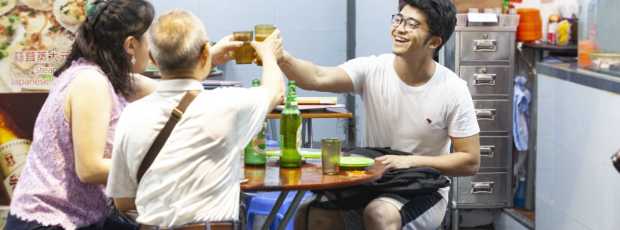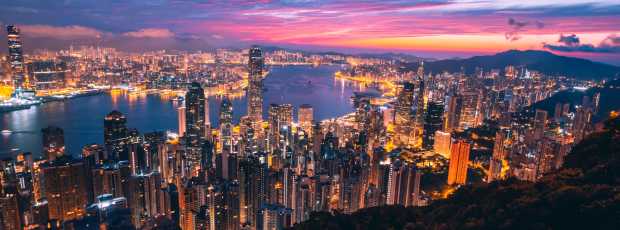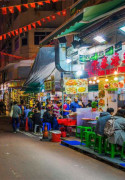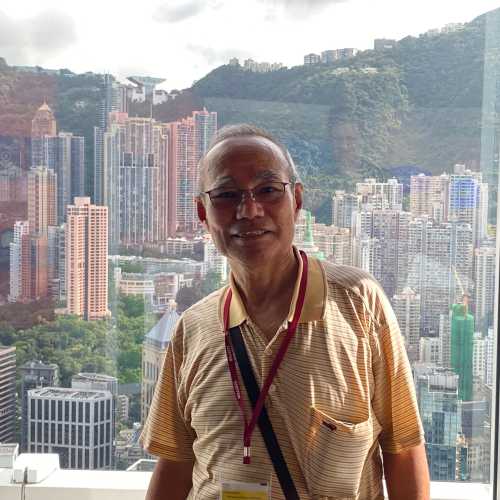Dennis was my tour guide. very knowledgeable about the city and food. Answered all my questions. We went very good food spots. had one of the best roast goose.Jorden, Hong Kong, 2025
Table Of Contents
- Classic Day Trips You Can't Skip
- Where Can I Go for Nature and Hiking Near Hong Kong?
- Where Should I Go for Food and Markets on a Day Trip?
- What Are the Best Historic and Cultural Day Trips?
- When Should I Visit Hong Kong for the Best Day Trips?
- Festival Day Trips Worth Planning Around
- What Are the Overrated Day Trips (And How to Fix Them)?
- Practical Tips for Day Trips From Hong Kong
- Frequently Asked Questions
- Final Thoughts: What Makes a Good Hong Kong Day Trip?
I'm Adrian, and I've lived in Hong Kong all my life. That's long enough to know the ferry schedules by heart and which trails empty out after 9 AM. Most visitors stick to Victoria Peak and the harbor, which is fine, but the best day trips from Hong Kong happen when you leave Hong Kong Island entirely.
Some Saturdays I'll catch the first bus to Lantau Peak at 5:30 AM, watch the sunrise over the South China Sea, then hike down to Ngong Ping by 10 AM for a bowl of vegetarian noodles at Po Lin Monastery before the cable car crowds arrive. By the time tourists are queuing at Tung Chung Station, I'm on a bus to Tai O, watching the afternoon light hit the stilt houses.
That's my version of a Hong Kong day trip. A rhythm of ferry times, trail markers, and knowing when to move before the crowds do.
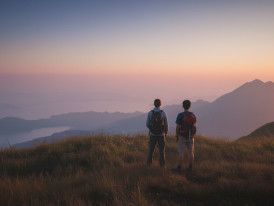
Hikers watching sunrise from Lantau Peak above clouds and distant Hong Kong islands
This guide covers the day trips I take on weekends and days off: island loops, ridge hikes, fishing villages, cross-border food runs, and cultural towns that still feel lived-in. Some cost less than a coffee. Some require a passport. All of them get you past the selfie spots and into places that feel less like tourist destinations and more like neighborhoods where people go about their lives.
When friends visit and want to see Hong Kong experiences beyond the skyline, I'll sometimes take them on one of the private hikes I host a few times each month. Otherwise, I just hand them this list and tell them to catch the early ferry.
Imagine Experiencing This for Real
A local can show you the vibe, flavors, and hidden gems up close.
Classic Day Trips You Can't Skip
These are the day trips every local recommends, not because they're trendy, but because they work so well. Are these hidden gems in Hong Kong? Yes, if your focus is on natural and local, not tourist traps.
Ferries run on time, the food's reliable, and you'll understand why people live here after a full day on any of these islands.
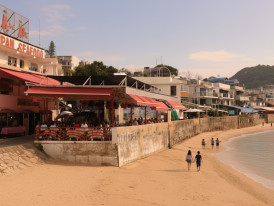
Waterfront seafood restaurants and sandy beach at Sok Kwu Wan on Lamma Island, Hong Kong
Lamma Island: Where Hong Kong Moves Slower
Time from Central: 30–40 minutes by ferry
Best for: Families, solo travelers, anyone allergic to crowds
Cost: HK$30–40 ferry round-trip, HK$150–300 for seafood lunch, HK$20–40 for café meals
Lamma is where expats, artists, and people who gave up on the MTR moved decades ago. No cars, no Starbucks, just two ferry piers connected by a walking trail that hugs the coast.
I come here on weekday afternoons when I need to reset. The hiking's easy, the villages are quiet, and the seafood restaurants in Sok Kwu Wan don't bother with menus tourists can't read. I usually order whatever's seasonal from the tank, a plate of stir-fried greens, and a beer, then sit watching boats come in.
What to Do:
- Walk the Yung Shue Wan to Sok Kwu Wan trail (90 minutes, mostly flat)
- Swim at Hung Shing Yeh Beach if it's warm
- Eat at one of the waterfront seafood spots in Sok Kwu Wan
- Stop at a vegetarian café in Yung Shue Wan. The tofu's better than it should be
Logistics: Ferries leave from Central Pier 4 every 30–60 minutes. Round-trip is around HK$30–40. The island has steps in the villages, but the coastal trail is manageable for most fitness levels. Ferry seats fill fast on sunny weekends. Show up 20 minutes early or accept you'll stand the whole ride.
Accessibility: The main trail has some steps and uneven paths. Not wheelchair-accessible, but fine for moderate mobility. Public toilets at both ferry piers.
QUICK PICK: Best for first-timers who want an easy island intro
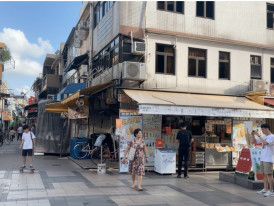
Street food and snack stalls near Cheung Chau beach, with locals and visitors browsing in a pedestrian street
Cheung Chau: The Snack Island
Time from Central: 35 minutes by fast ferry
Best for: Foodies, families, solo explorers, beach days
Cost: HK$25–40 ferry round-trip, HK$50–80 bike rental, HK$50–100 for snacks and lunch
If Lamma is the quiet island, Cheung Chau is the lively one. This is where locals go to eat fish balls, rent bikes, and spend a full day without spending much money.
The beaches aren't pristine, but Tung Wan Beach is clean enough for a few hours. The island loop by bike takes about two hours if you stop for photos, and the Pak Tai Temple sits on a hill with views that remind you why people live on islands.
What to Do:
- Walk the snack lanes near the ferry pier. Try the giant fish balls
- Rent a bike and loop the island (about 2 hours, easy terrain)
- Swim at Tung Wan Beach or explore the quieter Kwun Yam Beach
- Visit Pak Tai Temple for the hilltop view
- Grab mango mochi or egg waffles before the ferry back
Logistics: Fast ferries from Central Pier 5 take 35 minutes (HK$25–40). Slow ferries take an hour but cost less. Bike rentals are around HK$50–80 for the day. The island gets crowded on Sundays, so weekdays or Saturday mornings are better. Most snack stalls open by 9 AM, some close by 6 PM.
Accessibility: Flat terrain makes biking accessible for most. The main village has steps in places, but bike paths are smooth. Public toilets near the ferry pier and beaches.
QUICK PICK: Best for food lovers and relaxed beach days
This is the Hong Kong day trip tourists do, and honestly, they're not wrong. It's just better when you tweak the timing.

Tai O stilt houses over water with traditional wooden structures
Ngong Ping and Tai O Without the Crowds
Time from Tung Chung: 25 minutes by cable car, 50 minutes by bus
Best for: First-time visitors, hikers, culture seekers
Cost: HK$235 cable car round-trip OR HK$35 bus round-trip, HK$40–80 monastery lunch, HK$6–8 bus to Tai O, HK$30–60 for village snacks
This is the Hong Kong day trip tourists do, and honestly, they're not wrong. It's just better when you tweak the timing.
Most people take the cable car to Ngong Ping, see the Big Buddha (Tian Tan Buddha), eat overpriced noodles, then leave. I do it differently. I hike up to Lantau Peak before sunrise, walk down to Ngong Ping by 10 AM, eat vegetarian lunch at Po Lin Monastery before the tour groups arrive, then catch a bus to Tai O for the afternoon.
What to Do:
- Take the Ngong Ping 360 cable car for the views (skip if you hate queues)
- Visit Tian Tan Buddha and climb the 268 steps for the full effect
- Eat vegetarian lunch at Po Lin Monastery (cheap, filling, better than expected)
- Bus to Tai O village (20 minutes, HK$6–8)
- Walk the stilt house lanes and try dried seafood snacks
- Take a sampan boat ride through the channels if you want (HK$20–30)
Logistics: MTR to Tung Chung Station, then Ngong Ping 360 cable car (25 minutes, HK$235 round-trip) or Bus 23 (50 minutes, HK$16). The cable car queue can hit 60–90 minutes on weekends. Arrive before 9 AM or skip to the bus. From Ngong Ping to Tai O, take Bus 21 (20 minutes, HK$6–8). Ferries return to Central from Mui Wo if you want an alternative exit.
Accessibility: The cable car is wheelchair-accessible. Ngong Ping has paved paths but the Buddha requires climbing steps (elevator available). Tai O village has narrow lanes and steps. Not ideal for wheelchairs but manageable with assistance.
QUICK PICK: Best for mixing nature, culture, and Big Buddha photos
Where Can I Go for Nature and Hiking Near Hong Kong?
Hong Kong's hiking scene is better than it has any right to be. Within two hours of Central, you can be on ridge trails with views that stretch to mainland China, standing under waterfalls, or sweating up peaks that make you forget you're in a city of seven million.
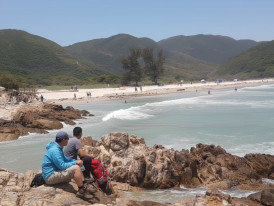
Turquoise water at Tai Long Wan beach with hikers resting
Sai Kung: The Outdoor Capital
Time from Central: 75 minutes by MTR and bus
Best for: Hikers, beach lovers, seafood addicts
Cost: HK$10 minibus, HK$10–20 trail buses, HK$30–50 kaito ferries, HK$300–600 seafood meals
Sai Kung is where serious hikers go. The town sits at the edge of Sai Kung East Country Park, which has some of the best coastal trails, clearest water, and emptiest beaches in Hong Kong. My usual order here is steamed fish, salt and pepper squid, and whatever clams are in season, shared with whoever I dragged out there.
What to Do:
- Hike to Tai Long Wan beaches (3–4 hours round-trip from Sai Wan Pavilion)
- Visit Sharp Island or Kiu Tsui Beach by kaito (small ferry, HK$30–50 round-trip)
- Walk the MacLehose Trail Section 1 or 2 for coastal views
- Eat seafood at the Sai Kung waterfront. Pick your fish, pay by weight
- Rent a kayak or SUP if you're into that
Logistics: MTR to Choi Hung or Diamond Hill, then Green Minibus 1A (30–40 minutes, HK$10). For hiking, take Bus 94 or 96R (weekends only) to trail access points. Sai Kung has ATMs, grocery stores, and gear shops if you need supplies. Beaches fill up fast in summer. Arrive before 10 AM or hike on weekdays.
Accessibility: Sai Kung Town is flat and walkable. Trails are steep and remote with limited facilities. Not wheelchair-accessible. Bring plenty of water as refill points are scarce on coastal routes.
QUICK PICK: Best for serious hiking and pristine beaches
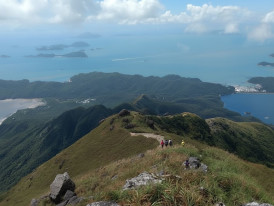
Ridge trail view from Lantau Peak with South China Sea and distant islands
Lantau Peak and Sunset Peak: The Best High-View Day Hikes
Time from Tung Chung: Varies by route (2–6 hours hiking)
Best for: Experienced hikers, sunrise chasers, solitude seekers
Cost: HK$5–8 bus to trailhead, free hiking, HK$40–80 for post-hike meal
Lantau has the city's two highest peaks, which makes it perfect for day trips from Hong Kong. Lantau Peak (Phoenix Mountain) and Sunset Peak. Both offer the kind of views that make you pull out your phone, realize photos can't capture it, then try anyway.
I really enjoy hiking Lantau Peak for sunrise a few times a year. You start in the dark, climb 900+ meters, and reach the summit as the sky shifts from black to purple to gold. The South China Sea stretches out below, and on clear days you can see Macau.
What to Do:
- Hike Lantau Peak from Pak Kung Au (3–4 hours round-trip, steep)
- Hike Sunset Peak from Pak Kung Au or Mui Wo (2.5–3.5 hours round-trip)
- Connect both peaks via Lantau Trail Sections 2–3 (8–10 hours, for serious hikers)
- Descend to Ngong Ping for food and transport
Logistics: MTR to Tung Chung, then Bus 3M to Pak Kung Au (20 minutes, HK$5–8). For sunrise hikes, catch the first bus around 5:30 AM. Trails are well-marked but steep. Bring water, snacks, and a headlamp for early starts. No facilities on the peaks. Descent to Ngong Ping takes 60–90 minutes.
Accessibility: These trails are steep, exposed, and remote. Not suitable for beginners or anyone with mobility issues. No wheelchair access. Bathrooms only at bus stops and Ngong Ping.
QUICK PICK: Best for sunrise hikes and Hong Kong's highest views
Want to Experience Lantau Firsthand?
Step into the neighborhood, scene, or story with someone who knows it inside out.

Bride's Pool waterfall cascading over rocks with forest and natural pools
The Best Waterfalls and Trails in the New Territories
Time from Central: 60–120 minutes depending on location
Best for: Waterfall chasers, ridge hikers, off-season explorers
Cost: HK$8–20 bus fares, free hiking, HK$50–100 for meals in nearby towns
The New Territories (NT) is where Hong Kong's hiking goes deep. Pat Sin Leng ridge, Tai Mo Shan (Hong Kong's tallest mountain), and Bride's Pool waterfall are all here, tucked into valleys and ridgelines that feel remote even though you're still technically in the city.
I like to visit Bride's Pool in spring when the waterfalls are running strong, and Pat Sin Leng in autumn when the ridge visibility is perfect. It's part of the reason why I love Hong Kong.
What to Do:
- Hike to Bride's Pool waterfall from Tai Mei Tuk (1.5 hours one-way, easy-moderate)
- Tackle Pat Sin Leng ridge (6–8 hours, difficult, for experienced hikers only)
- Summit Tai Mo Shan via Twisk or Route Twisk (3–4 hours round-trip)
- Explore Kadoorie Farm for a gentler nature day
Logistics: Access varies by trail. For Bride's Pool, take Bus 75K from Tai Po Market MTR (40 minutes, HK$8–10). For Pat Sin Leng, start from Tai Mei Tuk (bus or taxi from Tai Po). For Tai Mo Shan, take Bus 51 from Tsuen Wan. Bring full hiking gear for your excursions. These trails are remote, and phone signal can be weak. Check weather before going.
Accessibility: Bride's Pool has some paved sections but still requires moderate fitness to enjoy all the sights. Pat Sin Leng and Tai Mo Shan are advanced trails with no wheelchair access. Bathrooms only at trailhead parking areas.
QUICK PICK: Best for advanced hikers seeking remote trails
Travel Guides Can Only Take You So Far
We connect travelers with locals who shape days that actually fit your interests, not someone else’s checklist.
See how it worksWhere Should I Go for Food and Markets on a Day Trip?
Some of my favorite day trips are built around a single meal. Hong Kong's food towns, especially the ones outside the city center, still operate on rhythms that predate Instagram.
You eat what's in season, you pay by weight, and you leave full.
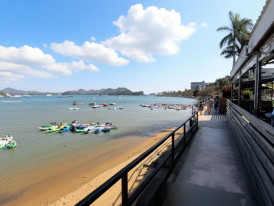
Seafood restaurants along Sai Kung waterfront
Time from Central: 60–90 minutes by MTR + bus
Best for: Seafood lovers, group meals, lazy Sundays
Cost: HK$300–600 per person for a full seafood meal
Sai Kung's waterfront restaurants are where locals go when someone's visiting from abroad and they want to impress.
You pick your fish, prawns, clams, and crab from tanks, then the kitchen steams, grills, or stir-fries them while you drink beer and watch boats come in.
It's not cheap, but it's fresh, and the portion sizes are built for sharing. I usually go with a group. Order too much, eat until we can't move, then walk it off along the pier.
Families arrive around 1 PM for Sunday lunch. Couples and small groups prefer early dinners around 6 PM. Weekday afternoons are quietest but some restaurants close between lunch and dinner service. If you're curious about exploring more of what to eat in Hong Kong, the Sai Kung waterfront gives you a good benchmark for how seafood pricing and freshness work across the city.
What to Eat:
- Steamed fish (pick from the tank, go for seasonal catch)
- Salt and pepper squid
- Ginger scallion crab
- Clams in black bean sauce
- Mantis shrimp if it's in season
Logistics: MTR to Choi Hung or Diamond Hill, then Green Minibus 1A (30–40 minutes, HK$10). Restaurants line the waterfront. Walk around and compare tank prices before committing. Expect to pay HK$300–600 per person for a full meal depending on what you order. Most places open from lunch through dinner.
Accessibility: The waterfront promenade is flat and wheelchair-accessible. Most restaurants have step-free entry or minimal steps. Public toilets near the bus terminal.
QUICK PICK: Best for fresh seafood and waterfront dining
Hungry to Taste Hong Kong Like a Local?
From tucked-away eateries to lively markets, discover flavors worth your time.

Dried seafood market stalls in Tai O with fish and shrimp products on display
Time from Tung Chung: 50 minutes by bus
Best for: Market wanderers, snack grazers, cultural explorers
Cost: HK$12–16 bus round-trip, HK$50–100 for snacks and treats
Tai O isn't just stilt houses. It's also one of Hong Kong's last working dried seafood markets.
The shops along the main lane sell shrimp paste, dried fish, scallops, and things I still can't identify. The smell is intense, but that's part of it. Worth seeing if you want to understand how fishing villages functioned before the tourism cycle kicked in.
What to Try:
- Egg waffles from the shops near the bus stop
- Dried squid (grilled fresh, not the vacuum-packed kind)
- Shrimp paste products if you're brave
- Herbal tea from the old tea houses
Logistics: MTR to Tung Chung, then Bus 11 to Tai O (50 minutes, HK$12–16). The market lanes are near the bus stop. Follow the crowds and your nose. Cash only at most stalls. Go mid-morning to early afternoon when shops are open but tour groups haven't peaked.
Accessibility: Tai O's lanes are narrow with uneven surfaces and steps. Not wheelchair-friendly. Public toilets near the bus stop and ferry pier.
QUICK PICK: Best for market snacks and village culture
Rethink the Day Trip
Swap rigid itineraries for a local-led day trip from Hong Kong that flexes with your interests, pace, and curiosity.
Portuguese colonial buildings in Taipa Village
Macau Day Trip for Food: Taipa Village
Time from Hong Kong: 60 minutes by ferry + 20 minutes by bus/taxi
Best for: Foodies, culture lovers, weekend escapers
Cost: HK$160–300 ferry round-trip, MOP$6–50 local transport, MOP$150–300 for meals
Macau is a separate administrative region from Hong Kong, but it's an easy cross-border day trip. Most people go for casinos. I go for Taipa Village, a maze of Portuguese-influenced streets where old ladies sell pork chop buns, bakeries make egg tarts the way they did in the 1950s, and the buildings still have tile facades. These are some of my favorite things to do in Hong Kong.
It's a full-day trip, but the food alone makes it worth it.
What to Eat:
- Egg tarts from Lord Stow's Bakery (the original location)
- Pork chop buns from Taipa Village Food Street
- Portuguese chicken rice at one of the old-school cafés
- Serradura (sawdust pudding) for dessert
Logistics: TurboJet or Cotai Water Jet ferries from Hong Kong-Macau Ferry Terminal or China Ferry Terminal in Tsim Sha Tsui (60 minutes, HK$160–300 round-trip). You'll need your passport. From Macau ferry terminals, take a free casino shuttle to central Macau, then bus or taxi to Taipa Village (20 minutes, MOP$6–50). Macau uses Macanese patacas, but HKD is accepted almost everywhere.
Accessibility: Taipa Village has narrow lanes with some steps, but main streets are flat. Not fully wheelchair-accessible. Public toilets in central plaza areas.
QUICK PICK: Best for Portuguese-Macanese food and heritage streets
Not Sure Where to Start with Hong Kong's Culinary Offerings?
A local can shape the day (or night) around what matters most to you.
What Are the Best Historic and Cultural Day Trips?
Hong Kong's history isn't all skyscrapers. The New Territories and outer islands still have walled villages, ancestral halls, and temples that predate British colonization by centuries.
These trips are quieter, less photogenic, but they'll teach you more about Hong Kong than any harbor tour.

Ancient pagoda along Ping Shan Heritage Trail
Ping Shan Heritage Trail
Time from Central: 45–60 minutes by MTR
Best for: History buffs, architecture lovers, half-day trips
Cost: HK$5–8 light rail, free trail entry and building access
The Ping Shan Heritage Trail connects walled villages, ancestral halls, and pagodas in the western New Territories. It's a 1 mile (1.6 km) loop that takes about two hours if you stop to read plaques and peek into courtyards.
Not thrilling, but grounding.
I come here when I want to walk without sweating, see something old, and remember that Hong Kong existed long before the MTR. The Tsui Sing Lau Pagoda is the only surviving ancient pagoda in Hong Kong. Almost 43 feet (13 meters), built in the 1400s, still standing.
For more context on how these villages fit into the broader story of best neighborhoods in Hong Kong, the heritage trails show you the pre-urban roots that shaped the city's development patterns.
What to See:
- Tsui Sing Lau Pagoda (built 1486)
- Tang Clan Ancestral Hall
- Sheung Cheung Wai walled village
- Kun Ting Study Hall
Logistics: MTR to Tin Shui Wai, then Light Rail to Ping Shan (10 minutes, HK$5–8). The trail is well-marked with English signage. Most buildings are free to enter during open hours (9 AM to 5 PM, closed Tuesdays). Bring water as there aren't many shops on the route.
Accessibility: The trail is mostly flat with some steps at building entrances. Wheelchairs can navigate most of the outdoor route, though interior access varies by building. Public toilets at the heritage center near Ping Shan Station.
QUICK PICK: Best for accessible heritage without the hiking

Walled village with traditional gate and fortification walls in New Territories.
Lots To See at Lung Yeuk Tau Heritage Trail
Time from Central: 60 minutes by MTR + bus
Best for: Hakka culture enthusiasts, quiet explorers
Cost: HK$6–10 bus fare, free trail and building entry
Lung Yeuk Tau is similar to Ping Shan but less visited and more rural. The trail connects five walled villages built by the Tang clan, all Hakka architecture, all centuries old.
Some villages are still inhabited, so tread respectfully.
What to See:
- Lo Wai walled village (fortified with gun towers)
- Ma Wat Wai and Wing Ning Wai villages
- Tang Chung Ling Ancestral Hall
Logistics: MTR to Fanling, then Bus 54K or Green Minibus 52K to Lung Yeuk Tau (20 minutes, HK$6–10). The trail is marked but less tourist-friendly than Ping Shan. Bring a map or download offline directions. Open daylight hours, free entry.
Accessibility: Rural paths with some uneven terrain and steps. Not wheelchair-accessible. Limited facilities, so plan bathroom stops before starting the trail.
QUICK PICK: Best for deeper Hakka heritage exploration
Wish You Could Just Ask a Local?
Book a quick video call and get insider answers to your trip questions.

Ruins of St Paul's facade with grand staircase
Explore Macau's Historic Center
Time from Hong Kong: 60 minutes by ferry
Best for: UNESCO architecture, temple hopping, European-meets-Cantonese vibes
Cost: HK$160–300 ferry round-trip, free entry to most sites, MOP$100–300 for meals
Macau's historic center is a UNESCO World Heritage Site. A cluster of churches, temples, squares, and colonial buildings compressed into walkable blocks.
The Ruins of St. Paul's is the postcard shot, but the real joy is wandering the back alleys where Cantonese incense shops sit next to Portuguese tile houses.
What to See:
- Ruins of St. Paul's (the façade of a 1600s Jesuit church)
- A-Ma Temple (dedicated to the sea goddess Mazu)
- Senado Square (Portuguese-style plaza)
- Monte Fort for city views
- Lou Kau Mansion (restored merchant house)
Logistics: Ferries from Hong Kong reach Macau in 60 minutes (HK$160–300 round-trip). From the ferry terminal, take free casino shuttles to central areas like Senado Square. The historic center is compact and best explored on foot. Passport required. Entry to most sites is free.
Accessibility: Senado Square and main streets are flat and paved. The Ruins of St. Paul's require climbing steps (no elevator). Many side streets have cobblestones and slopes. Partially wheelchair-accessible with planning. Public toilets at major sites.
QUICK PICK: Best for UNESCO heritage and Macanese culture
When Should I Visit Hong Kong for the Best Day Trips?
Hong Kong's seasons are real, and they matter for day trips. Summer is hot and humid with afternoon storms. Winter is drier. Spring and autumn are the sweet spots, but each season has its trips.
Spring Day Trips (March to May)
Spring is waterfall season. Bride's Pool and New Territories trails run full from winter rains, and the temperatures haven't hit sweat-through-your-shirt levels yet. Expect highs around 75–82°F (24–28°C), warm enough for hiking without the heavy humidity.
Wildflowers bloom on ridge trails, and the visibility is decent before summer haze sets in.
Easter weekend brings massive crowds to islands and beaches. Public holidays fill ferries and buses. Weekdays in April and early May offer the best balance of good weather and manageable crowds.
Best spring trips:
- Bride's Pool waterfall hikes
- Pat Sin Leng ridge when flowers are out
- Lamma or Cheung Chau for beach prep (water's still cold, but the islands are quiet)
- Sai Kung coastal trails before peak beach season
Spring offers the best conditions for waterfall hikes and ridge trails, with cooler temperatures and full water flow from winter rains. Visit Bride's Pool or Pat Sin Leng between March and May for ideal hiking weather.
Summer Day Trips (June to August)
Summer is beach season, but it's also typhoon season and brutally humid. Temperatures typically range from 82–91°F (28–33°C) with high humidity, so I stick to islands and coastal trails with swimming access, anything that lets me cool off halfway through.
Best summer trips:
- Cheung Chau and Lamma for beach access
- Sai Kung beaches (Tai Long Wan, Sharp Island)
- Macau if you need air conditioning and indoor culture
- Early morning Lantau hikes before heat sets in
Summer day trips should prioritize beach access and swimming options, as temperatures and humidity peak from June to August.
Autumn Day Trips (September to November)
Autumn is the best season for day trips. The humidity drops, the skies clear, and the temperatures hit the sweet spot where you can hike without dying. Expect comfortable highs between 70–82°F (21–28°C), with lower humidity than summer.
Best autumn trips:
- Lantau Peak and Sunset Peak for maximum visibility
- Pat Sin Leng ridge hikes
- Ma On Shan coastal sections
- Sai Kung multi-hour hikes without overheating
- Any island for end-of-season beach days
Autumn delivers Hong Kong's best hiking conditions, with clear skies, low humidity, and comfortable temperatures from September to November.
Winter Day Trips (December to February)
Winter is dry, cool, and perfect for high-altitude hikes. The beaches are empty, the peaks are crisp, and you'll need a jacket for early morning starts. Temperatures typically sit around 57–68°F (14–20°C), dropping lower on peaks and early mornings.
I do more Lantau hikes in winter. Sunrise at Lantau Peak, then down for hot noodle soup in Ngong Ping.
Best winter trips:
- Lantau Peak sunrise hikes (bring layers)
- Tai Mo Shan summit for cooler temperatures
- Macau for winter festivals and fewer tourists
- New Territories ridge hikes without heat stress
- Tai O village walks when weather is mild
Winter offers the coolest temperatures for high-altitude hikes, making Lantau Peak and Tai Mo Shan more comfortable from December to February.
Festival Day Trips Worth Planning Around
Hong Kong's festivals turn regular day trips into something locals actually mark on calendars. These aren't tourist shows, they're community events where islands and villages feel alive in ways the rest of the year doesn't capture.
Cheung Chau Bun Festival (April or May)
The Cheung Chau Bun Festival happens once a year, usually in late April or early May depending on the lunar calendar. Giant bamboo towers covered in steamed buns get erected in the village square, lion dances fill the streets, and locals parade through town dressed as floating children on poles.
It's chaotic, crowded, and one of the few festivals where you'll see traditional Taoist rituals mixed with street food and family picnics.

Lam Tsuen Wishing Trees
Lam Tsuen Wishing Trees (Lunar New Year, January or February)
During the first few days of Lunar New Year, locals head to Lam Tsuen in the New Territories to throw wishes written on paper tied to oranges into the branches of two ancient banyan trees.
It's a centuries-old tradition that still draws crowds, especially on the second and third days of the New Year when families make the trip together. The village sets up food stalls, incense burns constantly, and there's a genuine communal energy that's hard to find in the city.
Tai Po Dragon Boat Races (June, Tuen Ng Festival)
The Dragon Boat Festival (Tuen Ng) happens in June, and while races run across Hong Kong, the Tai Po races along Tolo Harbor feel less commercial and more neighborhood.
Teams train for months, families set up picnic tents along the water, and the whole event has a summer sports day vibe without the tourist buses. Locals go for the races, the rice dumplings (zongzi) sold by vendors, and because it's tradition.
What Are the Overrated Day Trips (And How to Fix Them)?
Not every popular Hong Kong day trip is worth your time, at least not the way most people do it. Here's what gets overhyped and how to tweak it.
Po Lin Monastery + Cable Car at Peak Time
The problem: The Ngong Ping 360 cable car queue can hit 90 minutes on weekends. The monastery complex is overrun by tour groups between 11 AM and 3 PM, and the Big Buddha steps turn into a photo conga line.
The fix: Go early (before 9 AM) or skip the cable car entirely and take Bus 23 from Tung Chung. Better yet, hike Lantau Peak first, arrive at Ngong Ping by 10 AM, eat lunch before the crowds, then bus to Tai O for the afternoon. You'll skip queues and see twice as much.
Dragon's Back Trail
The problem: Dragon's Back won the title of "Asia's Best Urban Hike" years ago, and now it's shoulder-to-shoulder on weekends. The views are decent, but the crowds kill the vibe.
The fix: Try High Junk Peak (near Sai Kung) or Ma On Shan ridge instead. Both offer similar coastal views with a fraction of the foot traffic. If you must do Dragon's Back, go on a weekday morning.
Macau Casinos as Main Event
The problem: Casinos are fine if gambling's your thing, but they're not Macau. The real culture is in Taipa Village, the UNESCO center, and the back streets where locals eat.
The fix: Visit the casinos if you're curious, but spend your time in Taipa Village, Senado Square, and Coloane's walking streets. That's where Macau's food, history, and Portuguese-Cantonese identity live. When you're ready to explore more of the nightlife scene back in Hong Kong, there are plenty of things to do in Hong Kong at night that go beyond the usual bar districts.
Shenzhen Malls
The problem: Shenzhen's malls are, well, malls. They're air-conditioned, they have brands, but they're not unique.
The fix: Visit OCT Loft (art district), Nantou Ancient Town (old village turned creative zone), or Shenzhen's weekend farmer's markets. Skip the luxury malls unless you're shopping specifically for tech.
Not Just Another Place on the List
Experience it through hidden corners and stories most visitors miss.
Practical Tips for Day Trips From Hong Kong
Here are the friction points I see people hit most often, and how to avoid them:
- Start from the right station. If you're flying in or out, Hong Kong Airport connects to the MTR via the Airport Express. From there, you can reach Central, Kowloon, or Tung Chung in under 30 minutes. Most island ferries leave from Central piers, so plan your first or last day trip accordingly.
- Use West Kowloon Station for cross-border trips. The high-speed train from West Kowloon reaches Shenzhen in 14 minutes and Guangzhou in 47 minutes. Immigration clearance happens at the station before departure, so factor in an extra 30–45 minutes for processing.
- Ferry tickets sell out on weekends. Show up 20–30 minutes early for island ferries during summer and public holidays, or you'll stand the whole ride.
- Download offline maps. Phone signal drops on remote trails like Pat Sin Leng and Tai Mo Shan. Save trail maps to your device before heading out.
- Keep a trip log for timing. If you plan to visit multiple islands or hike several peaks, note down ferry schedules and bus frequencies in your phone. The rhythm matters more than speed.
- Cash is still king in villages. Tai O, Lamma, and heritage trail towns don't always take cards. Bring HK$200–300 in small bills for snacks and entrance fees.
Frequently Asked Questions
1. What is the best day trip from Hong Kong for first-timers?
Lamma Island. It's a 30-minute ferry from Central, the hiking is easy, the beaches are clean, and the seafood restaurants are reliable. You'll get a feel for island life without the logistics stress of longer trips.
2. How much does a typical day trip from Hong Kong cost?
Budget trips (Lamma, Cheung Chau, Sai Kung hikes) cost HK$50–200 including transport and snacks. Mid-range trips with meals (Ngong Ping + Tai O, Sai Kung seafood) run HK$300–600. Macau trips with ferry, food, and entry fees can hit HK$800–1,500 depending on dining choices.
3. Can I do a day trip from Hong Kong to Macau?
Yes. Ferries run hourly from Hong Kong to Macau (60 minutes, HK$160–300 round-trip). You'll need your passport. Spend the morning in Macau's historic center, lunch in Taipa Village, then ferry back by evening. It's a full day but totally doable.
4. Which Hong Kong island is best for beaches?
Sai Kung's outer islands and Tai Long Wan beaches beat the accessible islands. For easy ferry access, Cheung Chau offers decent swimming at Tung Wan Beach. Lamma's Hung Shing Yeh Beach is quieter but smaller. If you want pristine water, take the kaito to Sharp Island from Sai Kung Town.
5. What day trips from Hong Kong are good for hiking?
Sai Kung for coastal hikes and beach combos. Lantau Peak and Sunset Peak for ridge hiking and views. Pat Sin Leng in the New Territories for advanced ridge trails. All are reachable in 60–120 minutes from Central via MTR and bus connections.
6. Do I need a visa for day trips to Shenzhen or Guangzhou?
Most nationalities need a visa for mainland China, including Shenzhen and Guangzhou. Check your country's requirements before booking. The high-speed train from West Kowloon Station reaches both cities quickly, but immigration clearance happens at the station before departure.
7. What's the difference between Lamma Island and Cheung Chau?
Lamma is quieter, less commercial, and better for easy coastal walks and vegetarian cafés. Cheung Chau is livelier with better snack food, bike rentals, and a more traditional fishing village vibe. Both are great. Lamma for chill, Cheung Chau for energy.
8. Is the Ngong Ping cable car worth the queue?
The views are good, but the queue isn't. If you arrive before 9 AM or go on a weekday, it's worth it. Otherwise, take Bus 23 from Tung Chung Station. It's faster, cheaper (HK$16 vs HK$235 round-trip), and skips the crowds entirely.
9. Can I visit multiple islands in one day?
Yes, but it's tight. You could do Cheung Chau in the morning (ferry at 8 AM, back by noon), then catch a ferry to Lamma for the afternoon. Ferry schedules align if you plan ahead, but you'll spend a lot of time on boats. Most people prefer one island per day to actually relax.
10. What day trip from Hong Kong has the best food?
Sai Kung for seafood, Taipa Village in Macau for Portuguese-Macanese cuisine, and Tai O for traditional dried seafood snacks. Each offers a different food culture. Pick what to eat based on your preferences and cravings.
11. Are Hong Kong day trips safe for solo travelers?
Extremely safe. Ferries, buses, and trails are well-used by solo hikers, families, and elderly locals. The biggest risk is getting lost on remote trails. Download offline maps and let someone know your route if you're hiking alone.
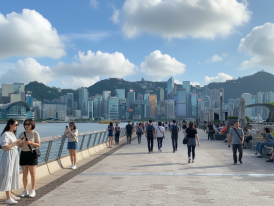
View of Hong Kong's skyline and tourists walking around
Final Thoughts: What Makes a Good Hong Kong Day Trip?
The best day trips in Hong Kong aren't about ticking off landmarks. They're about finding rhythms that match how you want to spend a day.
Some people want to sweat up a ridge and eat cold noodles at a summit. Some want to ferry to an island, eat fish, and read a book on a pier. Both are valid.
What I've learned after years of doing this: the trips that stick with you are the ones where you're not rushing. Where you catch the early ferry, spend an hour watching boats come in, eat something cheap and good, then realize you've been sitting there for two hours and don't care.
That's the version of Hong Kong that exists past Victoria Peak. The one where the transport logic actually works in your favor.
For those interested in exploring things to do in Hong Kong beyond the borders, there are plenty of China experiences that connect naturally with these day trips, especially if you're already making the journey across to Shenzhen or Guangzhou.
Discover More of Hong Kong
Ready to Plan Your Perfect Day in Hong Kong?
Start your experienceWhat if your day in Hong Kong was planned by someone who knows it — and you?
City Unscripted matches you with a local host who creates a private experience based on your interests, not a set route.
Plan Your ExperienceWish You Had a Local Friend in Hong Kong?
One who knows the city inside out and could plan a private day just for you? Our local hosts do exactly that: no scripts, no tourist traps, just the side of the city most people miss








